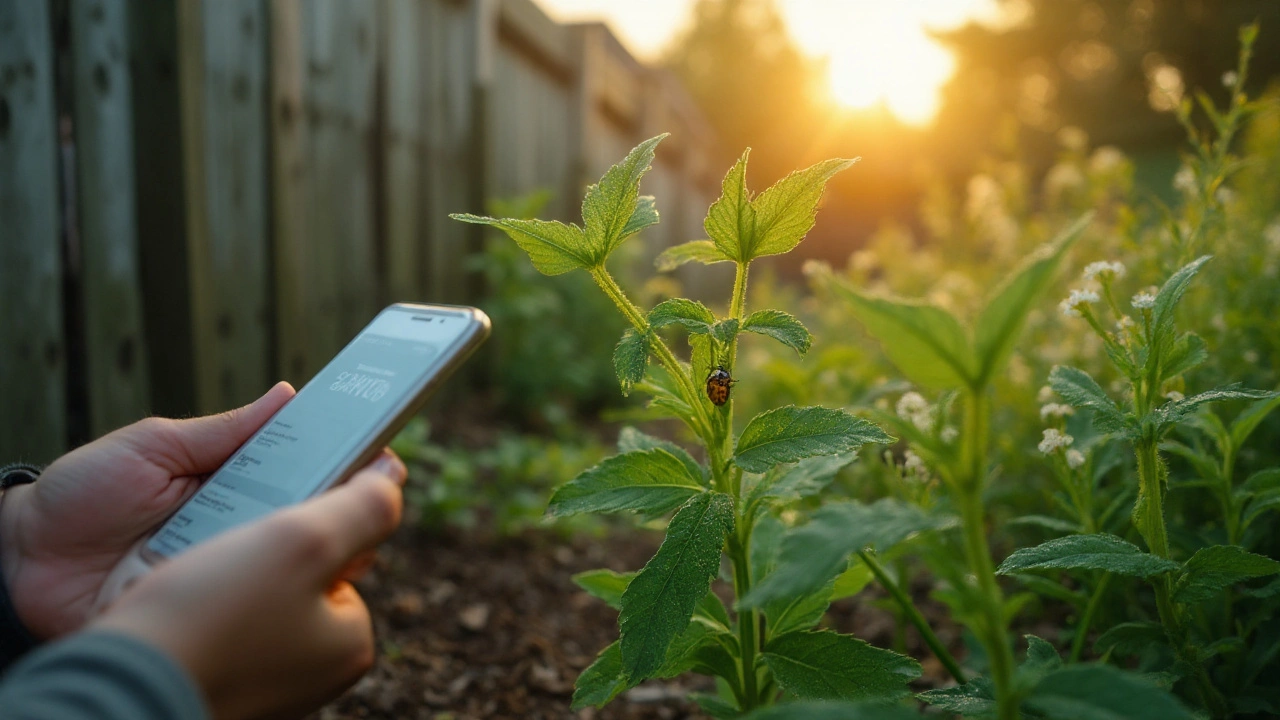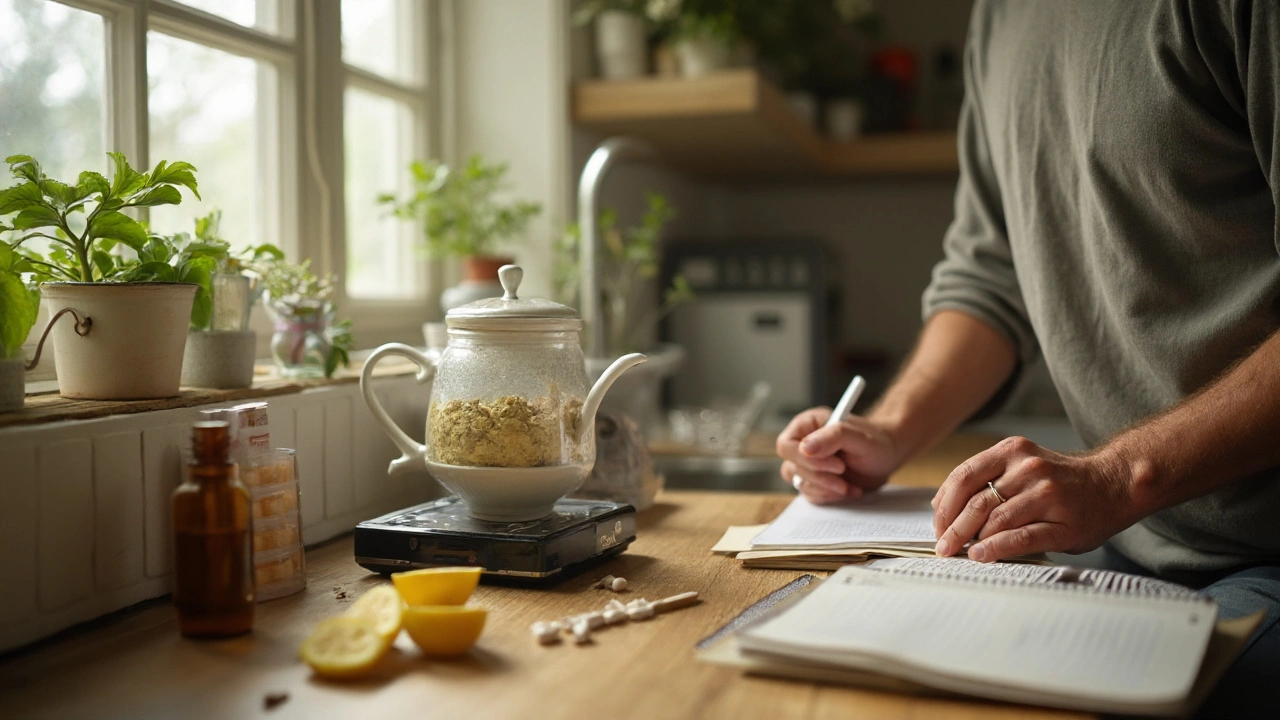
- Early evidence points to anti-inflammatory and antioxidant actions, but there are no high-quality human trials on goutweed for gout yet.
- Compounds like quercetin and chlorogenic acid may help moderate uric acid metabolism and inflammatory pathways.
- Use it as supportive care, not a replacement for prescribed gout meds; track symptoms and serum urate.
- Buy TGA- or third‑party-tested products, start low, and watch for interactions if you take gout or blood-thinning medicines.
- If you want clinical proof for gout today, cherries/tart cherry and specific flavonoids have stronger human data than goutweed.
You want a natural edge against joint pain and high uric acid, but you don’t want hype. Goutweed-Aegopodium podagraria-has a long folk history for gout and sore joints. The modern science is catching up, but it’s not all the way there. Think of it as a promising supporting act, not the headliner-something that could complement your plan while you keep the mainstay treatments steady. If you’re after goutweed benefits that actually translate into daily life, here’s what the lab work suggests, what we still don’t know, and how to use it safely and sensibly.
What goutweed is, how it might work, and what the evidence really says
Goutweed (Aegopodium podagraria) is a leafy herb in the carrot family (Apiaceae). It’s also called ground elder and bishop’s weed. Traditional European and Slavic medicine used the young leaves as food and as a remedy for “podagra”-gout-alongside general joint aches and swelling. Modern lab analysis shows the plant carries phenolic compounds (for example quercetin and kaempferol), phenolic acids (like chlorogenic and caffeic acid), and other antioxidant molecules typical of many medicinal herbs.
How could this help? There are three plausible routes:
- Inflammation pathway support: Flavonoids such as quercetin can modulate NF‑κB signaling and COX/LOX enzyme activity in cell models, which matters because a gout flare is a sharp inflammatory reaction to urate crystals.
- Oxidative stress buffering: Phenolics mop up reactive oxygen species in vitro. Less oxidative stress often means lower inflammatory tone around joints.
- Urate metabolism nudges: Some plant phenolics and flavonoids mildly inhibit xanthine oxidase in lab assays-the enzyme that makes uric acid-or encourage renal urate excretion in animal work. Whether goutweed does this meaningfully in people is still unproven.
What’s the strength of the evidence?
- Laboratory and phytochemistry: Solid. Extracts show antioxidant and anti‑inflammatory activity in standard assays published in journals focused on plant chemistry and ethnopharmacology.
- Animal data: Limited. Some related herbs with overlapping compounds show anti-inflammatory behavior in rodents, but direct animal studies on goutweed are sparse.
- Human trials: Not yet. There are no robust randomized trials directly testing goutweed for gout attacks, serum urate, or chronic joint pain. That gap matters.
What about the “gout part” specifically? Here’s the nuance:
- Quercetin, a flavonoid found in goutweed, has small human studies suggesting modest reductions in serum uric acid at supplemental doses, alongside anti-inflammatory effects. That doesn’t automatically prove whole-plant goutweed will do the same, but it explains why people are interested.
- Cherries/tart cherry juice have human data linking intake to fewer gout attacks and lower inflammatory markers. Goutweed hasn’t been tested head-to-head or in equivalent study designs.
Bottom line on the science: the rationale is biologically plausible and supported by lab data. The clinical proof for gout isn’t there yet for goutweed itself. Use it, if you choose to, as an add-on to a plan grounded in proven steps: keep serum urate below your target, manage weight, limit purine-heavy alcohol binges, and address comorbidities like metabolic syndrome.
| Option | Human evidence for gout | Primary mechanism | Best fit | Evidence strength |
|---|---|---|---|---|
| Goutweed (Aegopodium podagraria) | No randomized trials; lab support for anti-inflammatory/antioxidant actions | Inflammation modulation; antioxidant effects; possible mild xanthine oxidase impact (unproven in humans) | People seeking a gentle, plant-based adjunct | Low (for gout-specific outcomes) |
| Tart cherry (juice or extract) | Human observational and small trials show fewer flares and lower CRP/uric acid in some groups | Anthocyanins reduce inflammation/oxidative stress; possible urate effects | People with recurrent flares looking for evidence-backed food-based support | Moderate |
| Quercetin (isolated) | Small trials suggest modest uric acid reductions and anti-inflammatory effects | Xanthine oxidase modulation; NF‑κB/COX pathways | People targeting urate and inflammation with a well-studied flavonoid | Moderate |
| Turmeric/Curcumin | Good human data for general joint inflammation; not specific to gout flares | NF‑κB, COX‑2 modulation; antioxidant | People with mixed joint pain and stiffness | Moderate (for general joint symptoms) |
| Vitamin C | Some studies show small uric acid drops; unclear impact on flares | Increased uric acid excretion | People with borderline-high urate seeking mild support | Low-Moderate |
Who is the likely audience for goutweed? If you’re curious about botanicals and want a “low-risk, low-drama” helper you can layer into an already sound plan, it fits. If you want a substitute for allopurinol or febuxostat, goutweed won’t do that job.

How to use goutweed smartly: forms, dosing heuristics, safety, and buying guide
Forms you’ll actually find:
- Capsules or tablets: Typically dried leaf or aerial-part extracts. Some brands standardize to total phenolics or quercetin content.
- Tinctures/liquid extracts: Hydroalcoholic extracts (e.g., 1:3 or 1:5 herb-to-liquid ratios).
- Tea/infusion: Dried leaves steeped in hot water. Mild and food-like, but the dose of actives will be lower.
Practical dosing heuristics (not medical advice):
- Capsules: Start at the low end-around 250-300 mg of extract once daily with food for a week. If well tolerated, consider 300-500 mg twice daily. Stop if you notice side effects.
- Tincture: 1 mL in water, once or twice daily to start; adjust to 1-2 mL up to three times daily if tolerated. Tinctures contain alcohol-avoid if that’s an issue.
- Tea: 2-3 grams of dried leaf in 250 mL hot water for 10-15 minutes, once or twice daily. Keep expectations modest.
When to take it: With meals is easier on the stomach and pairs the flavonoids with fats, which may help absorption. Split doses (morning/evening) if you’re aiming for steady anti-inflammatory support.
What to pair it with: A basic anti-gout routine-steady hydration, steady urate-lowering therapy if prescribed, tart cherry or quercetin if your doctor is okay with it, and vitamin D/omega‑3s if you’re deficient. Avoid layering too many new supplements at once-add one, track two weeks, then decide.
Safety snapshot:
- Common side effects: Mild stomach upset, nausea, or loose stools for some people. Start low; take with food.
- Allergy alert: Goutweed is in the Apiaceae family (carrot, celery, parsley). If you react to these or mugwort pollen (cross-reactive), go slow or skip.
- Photosensitivity: Giant hogweed causes skin reactions; goutweed is a different species with a lower phototoxic profile. Still, if you notice unusual sun sensitivity, stop and reassess.
- Pregnancy/breastfeeding: Skip. There’s not enough data for confident use.
- Kidney disease or a history of kidney stones: Talk to your clinician first. Gout and kidneys are closely linked; don’t experiment solo.
Interactions to consider:
- Gout medications (allopurinol, febuxostat, probenecid, colchicine): Don’t stop or change prescribed doses. Adding goutweed on top could alter how you feel during dose adjustments; keep your prescriber in the loop.
- Blood thinners/antiplatelets and NSAIDs: Many botanicals influence clotting and GI lining. If you take warfarin, DOACs, aspirin, or daily NSAIDs, get medical clearance.
- Diuretics: Herbals with mild diuretic actions can shift electrolytes and uric acid handling. Monitor with your clinician if you’re on thiazides or loop diuretics.
Quality and regulation tips (with an Australian lens):
- Look for products that are TGA-listed (they carry an AUST L number) if buying locally. This signals baseline quality and labeling controls.
- If buying online or imported, look for third‑party testing logos (USP, NSF, Informed Choice) and batch-specific certificates of analysis showing identity, potency, and contaminants.
- Standardization matters. Prefer products that define a marker (e.g., total phenolics as gallic acid equivalents or a quercetin threshold) so you’re not guessing.
- Go single-ingredient first. Combo formulas can hide what’s working or causing side effects.
A simple step-by-step plan:
- Confirm your goal: fewer flares, lower pain, or long-term urate control. If serum urate is above your target, prioritise proven urate-lowering therapy.
- Get a baseline: pain days per month, last three serum urate results, kidney function, and current meds/supplements.
- Choose a quality goutweed product using the checks above. Avoid foraged or misidentified plant material.
- Start low, with food, for 7-14 days. Keep a quick symptom log (pain score 0-10, morning stiffness minutes, any side effects).
- Review after two weeks: if side effects occur, stop. If neutral or slightly helpful, you can continue for another 4-6 weeks before judging it.
- Re-test serum urate in line with your clinician’s plan (typically every 3 months if adjusting therapy). Don’t chase daily numbers.
What you should expect (realistically): If goutweed helps, it’ll likely feel like slightly calmer joints between flares, or a nudge in comfort around activity. Don’t expect it to abort an acute flare or drop urate by 100 μmol/L on its own. Think marginal gains.

Checklists, examples, and answers to the questions you’ll probably ask
Quick buying checklist:
- Identity confirmed (Aegopodium podagraria), part used (leaf or aerial parts), and extraction ratio/method listed.
- Standardized marker reported (e.g., total phenolics), with batch testing available.
- Free of common contaminants: heavy metals, pesticides, microbial counts within limits.
- Reasonable dosing range per capsule (250-500 mg); avoid “proprietary blends” that hide amounts.
- Clear expiry date, storage guidance, and contactable manufacturer.
Usage checklist:
- Introduce only one new supplement at a time.
- Log symptoms and any changes in stool, skin, or sleep.
- Keep hydration steady (uric acid likes water).
- Hold during acute GI illness or if starting new prescription meds-then restart only after you’re stable.
Two real-world scenarios:
- High uric acid, no flares yet: Your priority is bringing serum urate below target with lifestyle and, if needed, a urate-lowering drug. Goutweed can ride shotgun for inflammation tone, but it won’t replace the main driver.
- Recurrent flares on stable allopurinol: First review dose adequacy and adherence. If still flaring, discuss adding tart cherry or quercetin (both with stronger human data), and consider a cautious trial of goutweed for 8 weeks while tracking flare frequency.
Common pitfalls to avoid:
- Using goutweed to replace your urate-lowering therapy.
- Starting three new supplements at once; you won’t know what helps or harms.
- Ignoring kidney function and drug interactions.
- Buying untested, foraged, or misidentified products (Apiaceae has dangerous lookalikes).
Mini‑FAQ
- Can goutweed stop an acute gout attack? No. For acute flares, evidence-based options include NSAIDs, colchicine, or corticosteroids under medical guidance. Goutweed is for background support.
- How long until I notice anything? If it helps, you may feel easier movement or slightly less stiffness within 2-6 weeks. For flare frequency, give any adjunct at least 8-12 weeks before judging.
- Can I take it with allopurinol? Don’t change or stop allopurinol. If you want to try goutweed, run it by your doctor and monitor symptoms. Report any new rashes or GI issues promptly.
- Is it the same as bishop’s weed (Ajwain) from Indian cooking? No. Common names overlap. Check the Latin name: Aegopodium podagraria is goutweed/ground elder. Ajwain is Trachyspermum ammi.
- Is it safe if I have diabetes or hypertension? Possibly, but clear it with your clinician, especially if you’re on diuretics or multiple meds. Track blood pressure and glucose as usual.
- Any food synergies? A plant-rich diet, steady hydration, and limiting binge alcohol and high‑purine meals works best. Tart cherry and quercetin pair logically from a mechanisms point of view.
What the research community still owes you: a well-designed randomized controlled trial testing goutweed extract against placebo for (1) flare frequency, (2) pain/stiffness scores, and (3) serum urate, over at least 12-24 weeks. Until that lands, treat goutweed as a reasonable experiment-not a cure.
Next steps if you’re considering it today:
- Check your latest labs: serum urate (aim below your target per your clinician), eGFR, and liver enzymes.
- Clear the trial with your GP, rheumatologist, or pharmacist-bring the exact product label.
- Start a 6-8 week trial alongside your current plan, log symptoms weekly, and stick to the same exercise and diet routine so you can actually judge the effect.
- If nothing changes after 8 weeks, stop. Consider better-evidenced adjuncts like tart cherry extract or isolated quercetin, or revisit your urate-lowering therapy dose.
Troubleshooting by persona:
- Busy professional: Use a once-daily capsule at breakfast and a simple notes app to tick off pain and stiffness. Refill calendar reminders so you don’t miss doses.
- On multiple meds: Book a pharmacist consult. Bring your full list (prescriptions, OTC, supplements). Ask specifically about clotting, kidneys, and drug-drug interactions.
- Budget-conscious: Skip premium blends. Choose a single-ingredient, tested product. If you need to prioritize, tart cherry or quercetin may deliver more bang per dollar for gout-specific outcomes.
- Sensitive stomach: Choose tea or a lower-dose capsule with meals. Avoid tinctures if alcohol irritates your gut.
One last sanity check: the supplement market moves fast, but physiology doesn’t. Set a clear goal, run a clean experiment, and keep what measurably helps. If goutweed earns its place in your routine, great. If not, you’ve learned quickly and safely without derailing the core of your plan.





There are 18 Comments
Chloe McDonald
also, pair it with tart cherry juice. it's like the dynamic duo for joint chill.
Hobert Finn Bodfish
Andrea Galetto
Daniel Rogers
also, hydration. drink water. always. even when you don't feel like it.
Chris Remo
Michael Herr
Danie Joy
Katherine Stapp
Frank De Silva
KJ Miller
Claire Battista
just be patient. and track.
Erin DeGroot
thank you for not treating us like idiots who just want a miracle.
Stephanie Bryant
Drashti patel
Kaitlin Crockett
Manvika Gupta
Tracy Blake
but still, check your labs.
Chloe McDonald
Write a comment
Your email address will not be published. Required fields are marked *